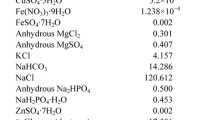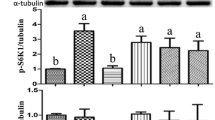Abstract
Purpose
The mechanism of dietary amino acids in regulating milk protein synthesis at the translational level is not well understood. Numerous studies have shown that the amino acid signal is transferred through the mammalian target of rapamycin (mTOR) pathway; however, the extracellular amino acid-sensing mechanism that activates mTOR complex 1 is unknown. We tested the hypotheses that the T1R1/T1R3 heterodimer functions as a direct sensor of the fed state and amino acid availability preceding the mTOR pathway and affects milk protein synthesis in mammary epithelial cells.
Methods
The expression of T1R1 was repressed by T1R1 siRNA in mouse mammary epithelial cells model (HC11). Western blot was used to analyze activity of the mTOR pathway and β-casein expression, and quantitative real-time RT-PCR was used to analyze the change in mRNA abundance of amino acid transporters.
Results
The transcripts and proteins of T1R1 and T1R3 were detected in HC11 cells and mouse mammary gland tissue. siRNA silencing of T1R1 repressed β-casein synthesis in HC11 cells both with and without essential amino acids present in the culture medium. The phosphorylation of mTOR, S6K, and 4EBP1 in T1R1 knockdown HC11 cells declined to 25, 50, and 30 %, indicating T1R1 knockdown repressed the activity of the mTOR pathway. T1R1 knockdown increased the mRNAs coding three important amino acid transporters (SLC1A5 and SLC3A2/SLC7A5). Activation of the mTOR pathway was partially repressed by T1R1 siRNA or SLC7A5/SLC3A2 inhibitor (BCH, 10 mM), and the combination of these two treatments further repressed the activity of this pathway.
Conclusion
T1R1/T1R3 serves as sensor of extracellular amino acids in mouse mammary epithelial cells and involved in milk protein synthesis regulation.






Similar content being viewed by others
References
Manjarin R, Bequette BJ, Wu G, Trottier NL (2014) Linking our understanding of mammary gland metabolism to amino acid nutrition. Amino Acids 46(11):2447–2462
Appuhamy JA, Bell AL, Nayananjalie WA, Escobar J, Hanigan MD (2011) Essential amino acids regulate both initiation and elongation of mRNA translation independent of insulin in MAC-T cells and bovine mammary tissue slices. J Nutr 141(6):1209–1215
Moshel Y, Rhoads RE, Barash I (2006) Role of amino acids in translational mechanisms governing milk protein synthesis in murine and ruminant mammary epithelial cells. J Cell Biochem 98(3):685–700
Appuhamy JA, Knoebel NA, Nayananjalie WA, Escobar J, Hanigan MD (2012) Isoleucine and leucine independently regulate mTOR signaling and protein synthesis in MAC-T cells and bovine mammary tissue slices. J Nutr 142(3):484–491
Rulquin H, Pisulewski PM (2006) Effects of graded levels of duodenal infusions of leucine on mammary uptake and output in lactating dairy cows. J Dairy Res 73(3):328–339
Haque MN, Rulquin H, Lemosquet S (2013) Milk protein responses in dairy cows to changes in postruminal supplies of arginine, isoleucine, and valine. J Dairy Sci 96(1):420–430
Haque MN, Rulquin H, Andrade A, Faverdin P, Peyraud JL, Lemosquet S (2012) Milk protein synthesis in response to the provision of an “ideal” amino acid profile at 2 levels of metabolizable protein supply in dairy cows. J Dairy Sci 95(10):5876–5887
Haque MN, Guinard-Flament J, Lamberton P, Mustière C, Lemosquet S (2015) Changes in mammary metabolism in response to the provision of an ideal amino acid profile at 2 levels of metabolizable protein supply in dairy cows: consequences on efficiency. J Dairy Sci 98(6):3951–3968
Toerien CA, Trout DR, Cant JP (2010) Nutritional stimulation of milk protein yield of cows is associated with changes in phosphorylation of mammary eukaryotic initiation factor 2 and ribosomal s6 kinase 1. J Nutr 140(2):285–292
Beugnet A, Tee AR, Taylor PM, Proud CG (2003) Regulation of targets of mTOR (mammalian target of rapamycin) signalling by intracellular amino acid availability. Biochem J 372(Pt 2):555–566
Kimball SR, Jefferson LS (2006) New functions for amino acids: effects on gene transcription and translation. Am J Clin Nutr 83(2):S500–S507
Wang X, Proud CG (2006) The mTOR pathway in the control of protein synthesis. Physiology (Bethesda) 21:362–369
Prizant RL, Barash I (2008) Negative effects of the amino acids Lys, His, and Thr on S6K1 phosphorylation in mammary epithelial cells. J Cell Biochem 105(4):1038–1047
Arriola Apelo SI, Singer LM, Lin XY, McGilliard ML, St-Pierre NR, Hanigan MD (2014) Isoleucine, leucine, methionine, and threonine effects on mammalian target of rapamycin signaling in mammary tissue. J Dairy Sci 97(2):1047–1056
Hyde R, Taylor PM, Hundal HS (2003) Amino acid transporters: roles in amino acid sensing and signalling in animal cells. Biochem J 373(Pt 1):1–18
Hundal HS, Taylor PM (2009) Amino acid transceptors: gate keepers of nutrient exchange and regulators of nutrient signaling. Am J Physiol Endocrinol Metab 296(4):E603–E613
Forsberg H, Ljungdahl PO (2001) Sensors of extracellular nutrients in Saccharomyces cerevisiae. Curr Genet 40(2):91–109
Nelson G, Chandrashekar J, Hoon MA, Feng L, Zhao G, Ryba NJ, Zuker CS (2002) An amino-acid taste receptor. Nature 416(6877):199–202
Muroi Y, Ishii T (2012) Umami taste receptor functions as an amino acid sensor via Gαs subunit in N1E-115 neuroblastoma cells. J Cell Biochem 113(5):1654–1662
Wang JH, Inoue T, Higashiyama M, Guth PH, Engel E, Kaunitz JD, Akiba Y (2011) Umami receptor activation increases duodenal bicarbonate secretion via glucagon-like peptide-2 release in rats. J Pharmacol Exp Ther 339(2):464–473
Daly K, Al-Rammahi M, Moran A, Marcello M, Ninomiya Y, Shirazi-Beechey SP (2013) Sensing of amino acids by the gut-expressed taste receptor T1R1-T1R3 stimulates CCK secretion. Am J Physiol Gastrointest Liver Physiol 304(3):G271–G282
Wauson EM, Zaganjor E, Lee AY, Guerra ML, Ghosh AB, Bookout AL, Chambers CP, Jivan A, McGlynn K, Hutchison MR, Deberardinis RJ, Cobb MH (2012) The G protein-coupled taste receptor T1R1/T1R3 regulates mTORC1 and autophagy. Mol Cell 47(6):851–862
Ball RK, Friis RR, Schoenenberger CA, Doppler W, Groner B (1988) Prolactin regulation of beta-casein gene expression and of a cytosolic 120-kd protein in a cloned mouse mammary epithelial cell line. EMBO J 7(7):2089–2095
Towbin H, Staehelin T, Gordon J (1979) Electrophoretic transfer of proteins from polyacrylamide gels to nitrocellulose sheets: procedure and some applications. Proc Natl Acad Sci USA 76(9):4350–4354
Nicklin P, Bergman P, Zhang B, Triantafellow E, Wang H, Nyfeler B, Yang H, Hild M, Kung C, Wilson C, Myer VE, MacKeigan JP, Porter JA, Wang YK, Cantley LC, Finan PM, Murphy LO (2009) Bidirectional transport of amino acids regulates mTOR and autophagy. Cell 136(3):521–534
Kiuchi S, Yamada T, Kiyokawa N, Saito T, Fujimoto J, Yasue H (2006) Genomic structure of swine taste receptor family 1 member 3, TAS1R3, and its expression in tissues. Cytogenet Genome Res 115(1):51–61
Jewell JL, Guan KL (2013) Nutrient signaling to mTOR and cell growth. Trends Biochem Sci 38(5):233–242
Efeyan A, Comb WC, Sabatini DM (2015) Nutrient-sensing mechanisms and pathways. Nature 517(7534):302–310
Wolfson RL, Chantranupong L, Saxton RA, Shen K, Scaria SM, Cantor JR, Sabatini DM (2016) Sestrin2 is a leucine sensor for the mTORC1 pathway. Science 351(6268):43–48
Bauch C, Forster N, Loffing-Cueni D, Summa V, Verrey F (2003) Functional cooperation of epithelial heteromeric amino acid transporters expressed in madin-darby canine kidney cells. J Biol Chem 278(2):1316–1322
Thevelein JM, Voordeckers K (2009) Functioning and evolutionary significance of nutrient transceptors. Mol Biol Evol 26(11):2407–2414
Acknowledgments
This work was partly funded by National Natural Science Foundation of China (31472077, 31101703), Natural Science Foundation of Jiangsu Province (BK20160217), Natural Science Foundation of Xuzhou Normal University (No.14XLA06), Jiangsu Overseas Research and Training Program for University Prominent Young and Middle-aged Teachers and Presidents Project, and a Project Funded by the Priority Academic Program Development of Jiangsu Higher Education Institutions.
Author information
Authors and Affiliations
Corresponding authors
Ethics declarations
Conflict of interest
On behalf of all authors, the corresponding author states that there is no conflict of interest.
Rights and permissions
About this article
Cite this article
Wang, Y., Liu, J., Wu, H. et al. Amino acids regulate mTOR pathway and milk protein synthesis in a mouse mammary epithelial cell line is partly mediated by T1R1/T1R3. Eur J Nutr 56, 2467–2474 (2017). https://doi.org/10.1007/s00394-016-1282-1
Received:
Accepted:
Published:
Issue Date:
DOI: https://doi.org/10.1007/s00394-016-1282-1




